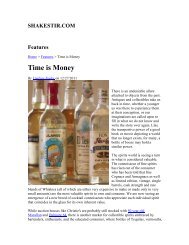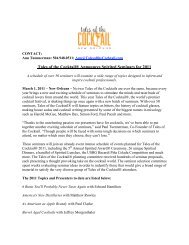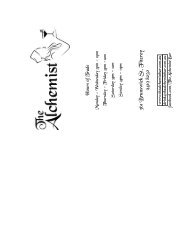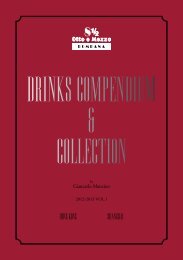What's a Martinez? - Tales of the Cocktail
What's a Martinez? - Tales of the Cocktail
What's a Martinez? - Tales of the Cocktail
You also want an ePaper? Increase the reach of your titles
YUMPU automatically turns print PDFs into web optimized ePapers that Google loves.
Subscribe to our newsletter<br />
bringing drinks to life<br />
home Links about us contact b&t<br />
<strong>What's</strong> a <strong>Martinez</strong><br />
March 7, 2012 - 7:39pm | by Daniel Priseman<br />
Like<br />
Chris Doig, Hatvani Zília and 69 o<strong>the</strong>rs like this.<br />
On <strong>the</strong> surface <strong>of</strong> it, <strong>the</strong> question <strong>of</strong> ‘what’s a <strong>Martinez</strong>’ seems pretty selfexplanatory;<br />
after all, you can walk into any good bar, order one and be<br />
pretty confident about what you’ll get in your glass. The chances are you’ll<br />
get a lot <strong>of</strong> sweet vermouth, a little bit <strong>of</strong> gin, a splash <strong>of</strong> maraschino and<br />
a dash or two <strong>of</strong> bitters. Occasionally <strong>the</strong>re might be a bit more gin and a<br />
little less vermouth, or you might get Boker’s bitters or orange bitters;<br />
you might even get a splash <strong>of</strong> curacao instead <strong>of</strong> maraschino, but all in<br />
all you’re likely to receive a sweet vermouth and gin cocktail, with a<br />
splash <strong>of</strong> liqueur and a dose <strong>of</strong> bitters.<br />
Links<br />
bar tools (1)<br />
blogs (6)<br />
brands we like: bourbon<br />
(2)<br />
brands we like: cachaca<br />
(1)<br />
brands we like: gin (2)<br />
Over <strong>the</strong> years <strong>the</strong>re has been much debate about <strong>the</strong> intertwined history<br />
<strong>of</strong> <strong>the</strong> <strong>Martinez</strong> cocktail and <strong>the</strong> Martini, with speculation about whe<strong>the</strong>r<br />
<strong>the</strong> <strong>Martinez</strong> might be <strong>the</strong> forefa<strong>the</strong>r <strong>of</strong> <strong>the</strong> Martini or, if in fact <strong>the</strong>y were<br />
once <strong>the</strong> same drink, known by similar names but got confused over <strong>the</strong><br />
years. The truth is we’re never likely to know, but somewhere along <strong>the</strong><br />
way <strong>the</strong> two drinks have diverged to become completely different<br />
cocktails. It’s now accepted that <strong>the</strong> Martini is made with dry vermouth<br />
and <strong>the</strong> <strong>Martinez</strong> with sweet, <strong>the</strong> former has no liqueur added but <strong>the</strong><br />
latter is usually enriched with a barspoon <strong>of</strong> maraschino. The Martini is<br />
heavy on gin, with vermouth playing a supporting role, whereas <strong>the</strong> <strong>Martinez</strong> is a vermouth-led cocktail. In o<strong>the</strong>r words <strong>the</strong>y are<br />
only connected in as much as that <strong>the</strong>y are in <strong>the</strong> broad family <strong>of</strong> gin and vermouth based drinks.<br />
So when I recently made a drink using <strong>the</strong> same ingredients as a modern <strong>Martinez</strong>, but in vastly different proportions, and<br />
posted <strong>the</strong> recipe on Twitter, I was shocked to hear people calling it a <strong>Martinez</strong>. After all, three parts gin to one part sweet<br />
vermouth makes a completely different cocktail, in fact it was closer in pr<strong>of</strong>ile to a Gin and It. An online discussion quickly<br />
ensued about what people consider a <strong>Martinez</strong> cocktail to be and what <strong>the</strong> original spec was; it soon became clear that this is a<br />
cocktail with a hazy past, and even a somewhat muddled present.<br />
Inspired by my previous blog about <strong>the</strong> Corpse Reviver, I thought that with a little help I might be able to unravel <strong>the</strong> past <strong>of</strong><br />
this delicious, but misunderstood drink. I immediately posted some questions on Facebook and Twitter and started to put<br />
toge<strong>the</strong>r a timeline for <strong>the</strong> <strong>Martinez</strong> cocktail. Once again Adam Elmegirab and Craig Harper came to my aid contributinging<br />
various recipes for <strong>the</strong> <strong>Martinez</strong> in <strong>the</strong> hopes <strong>of</strong> understanding how we have arrived at <strong>the</strong> modern version we know today.<br />
Along <strong>the</strong> way our research expanded into <strong>the</strong> entire family <strong>of</strong> gin, vermouth and bitters based cocktails, but that’s a subject for<br />
ano<strong>the</strong>r time. In fact Adam is already well on his way to amassing a broad history <strong>of</strong> this family <strong>of</strong> drinks.<br />
WHY SO MUCH CONFUSION<br />
It seems clear from <strong>the</strong> modern viewpoint that <strong>the</strong> <strong>Martinez</strong> cocktail is two parts sweet vermouth to one part gin, with a splash<br />
<strong>of</strong> maraschino and a dash <strong>of</strong> bitters. In fact when I asked bartenders what <strong>the</strong>ir standard recipe is for this drink, all <strong>of</strong> <strong>the</strong>m said<br />
two to one ratios in favour <strong>of</strong> sweet vermouth, and almost everyone said maraschino and ei<strong>the</strong>r Boker’s or orange bitters. So if<br />
<strong>the</strong>re is a reasonably standard modern recipe, <strong>the</strong>n why am I implying that <strong>the</strong>re is some confusion as to <strong>the</strong> recipe for <strong>the</strong><br />
<strong>Martinez</strong> It comes down to two things: vermouth choice and ratios.<br />
You see if you refer to cocktail books from <strong>the</strong> 1930s and 40s most <strong>of</strong> <strong>the</strong>m actually call for dry vermouth instead <strong>of</strong> sweet, in<br />
fact <strong>the</strong> first time I made myself a <strong>Martinez</strong> I followed <strong>the</strong> recipe from <strong>the</strong> Savoy <strong>Cocktail</strong> Book, which calls for dry. So to me<br />
this has always been a drink that can be served both ways, sweet and dry, which leaves <strong>the</strong> drink open to interpretation<br />
depending on where you first read <strong>the</strong> recipe. In addition, I’ve seen recipes calling for equal parts gin and vermouth, so even<br />
<strong>the</strong> ratio can be called into question.<br />
This got me wondering about when <strong>the</strong> recipe changed from sweet to dry, and <strong>the</strong>n back again to sweet. The trouble, I soon<br />
realised from chatting with Adam and Craig, is that <strong>the</strong>re are surprisingly few recipes for <strong>the</strong> <strong>Martinez</strong> in any early cocktail<br />
books. In fact as Craig pointed out, you almost never see <strong>the</strong> <strong>Martinez</strong> and <strong>the</strong> Martini in <strong>the</strong> same book, so is it possible <strong>the</strong>y<br />
are <strong>the</strong> same drink Was <strong>the</strong> name and <strong>the</strong> recipe muddled in <strong>the</strong> early years <strong>of</strong> its invention, leaving us with two cocktails<br />
where originally <strong>the</strong>re was just one
ZIM ZAM ZIMMY<br />
WHAT'S IN A NAME<br />
The first recipe I have been able to find for <strong>the</strong> <strong>Martinez</strong> cocktail is from 1884, with<br />
only a handful <strong>of</strong> fur<strong>the</strong>r recipes over <strong>the</strong> following two decades. Likewise <strong>the</strong> Martini<br />
makes an appearance only a couple <strong>of</strong> years after <strong>the</strong> <strong>Martinez</strong>, and has its own<br />
handful <strong>of</strong> recipes in <strong>the</strong> late 1800s. To make it even more confusing <strong>the</strong>re are o<strong>the</strong>r<br />
drinks from <strong>the</strong> same era such as <strong>the</strong> Martine and Marguerite that also combine gin,<br />
vermouth and bitters. So is this just a classic case <strong>of</strong> Chinese whispers, with a drink<br />
being created and named, and <strong>the</strong>n being passed on from bar to bar and<br />
slowly changing<br />
There are <strong>of</strong> course stories about where <strong>the</strong> name came from; some claiming it for<br />
<strong>the</strong> town <strong>of</strong> <strong>Martinez</strong> in California, o<strong>the</strong>rs saying it was made for a customer who<br />
used to travel to <strong>the</strong> town. Still o<strong>the</strong>rs claim that <strong>the</strong> Martini actually came first and<br />
that <strong>the</strong> <strong>Martinez</strong> was just ano<strong>the</strong>r name for <strong>the</strong> same drink. Then again <strong>the</strong>re are<br />
stories <strong>of</strong> a judge from New York whose name was Martine, so some believe this to<br />
be an east coast creation and nothing whatsoever to do with <strong>the</strong> town in California.<br />
Truth be told we’re unlikely to ever know <strong>the</strong> origins <strong>of</strong> <strong>the</strong> name.<br />
Many claim that <strong>the</strong> <strong>Martinez</strong> was created in <strong>the</strong> 1860s and that <strong>the</strong> Martini came<br />
into being in <strong>the</strong> 1870s, but this is still hard to prove, so for me it seems sensible to<br />
start with recipes that have been recorded in cocktail books. But if all we have are a handful scattered through a few<br />
publications over <strong>the</strong> years, <strong>the</strong>n what’s <strong>the</strong> truth about this drink Has it always been <strong>the</strong> sweet vermouth based drink we<br />
know today Well let’s see if we can make some sense <strong>of</strong> it simply by tracking it through <strong>the</strong> years.<br />
THE EARLY DAYS OF THE MARTINEZ<br />
As I mentioned earlier, <strong>the</strong> first recipe for <strong>the</strong> <strong>Martinez</strong> that I’ve found (and I’d<br />
love to hear from anyone who knows <strong>of</strong> an earlier one, or a version I’ve missed<br />
from <strong>the</strong> timeline below) is from O H Byron in 1884. Unfortunately all he has to<br />
say on <strong>the</strong> subject is this:<br />
“ Same as Manhattan, only you substitute gin for whisky.”<br />
Now this wouldn’t be a problem if he had been considerate enough to list only<br />
one recipe for <strong>the</strong> Manhattan. There were unfortunately two Manhattan recipes<br />
listed directly above <strong>the</strong> entry for <strong>the</strong> <strong>Martinez</strong>, one with sweet vermouth one<br />
with dry (for full recipes see <strong>the</strong> timeline fur<strong>the</strong>r down <strong>the</strong> page). So maybe, as<br />
with many vermouth and spirit cocktails <strong>the</strong> <strong>Martinez</strong> was originally a drink that<br />
could be ordered sweet or dry The problem with this <strong>the</strong>ory is that we never see<br />
<strong>the</strong> <strong>Martinez</strong> listed in books with <strong>the</strong> two styles <strong>of</strong>fered, as we do with <strong>the</strong> Martini<br />
and <strong>the</strong> Manhattan. Often <strong>the</strong>se drinks are <strong>of</strong>fered, for example, as <strong>the</strong> Dry<br />
Martini or <strong>the</strong> Sweet Martini with distinct recipes. Nowhere have I found <strong>the</strong> same<br />
for <strong>the</strong> <strong>Martinez</strong>. Still it’s a thought…<br />
The next recipe that we find in print is from <strong>the</strong> 1887 revised edition <strong>of</strong> Jerry<br />
Thomas’ Bon Vivants Companion, which was published two years after his death. The recipe calls for one part Old Tom Gin to<br />
two parts ‘vermouth’. We know from records that most vermouth in <strong>the</strong> US at this time was Italian (sweet) vermouth, and it’s<br />
taken for granted that unless French vermouth is specified in a recipe, <strong>the</strong>n Italian would have be used. So it seems likely that<br />
this recipe is <strong>the</strong> one responsible for our current understanding <strong>of</strong> <strong>the</strong> <strong>Martinez</strong> as being a sweet vermouth cocktail.<br />
Next up we have <strong>the</strong> <strong>Martinez</strong> recipe listed in Stuart’s Fancy Drinks from 1896, but unfortunately it seems that he has<br />
plagiarised O H Byron, as his entry is identical to <strong>the</strong> 1884 entry in that book (word for word, down to <strong>the</strong> order <strong>of</strong> <strong>the</strong> drinks).<br />
So o<strong>the</strong>r than being a second time that we see both a sweet and dry version, it doesn’t actually help us to understand how this<br />
drink might originally have been served.<br />
Fast forward almost a decade to 1905 and we find a recipe for <strong>the</strong> <strong>Martinez</strong> in <strong>the</strong> romantically named Consolidated Library <strong>of</strong><br />
Modern Cooking and Household Recipes, volume 5 by Christine Terhune Herrick and M. Harland, which is remarkably similar to<br />
Jerry Thomas' recipe above. The recipe calls for two parts vermouth (sweet) to one part gin with two dashes <strong>of</strong> maraschino<br />
and a dash <strong>of</strong> Boker’s Bitters. Gum syrup may be added if desired. The parting shot is to point out that this recipe is exactly <strong>the</strong><br />
same as <strong>the</strong> one before, which as you might have guessed, is for <strong>the</strong> Manhattan.<br />
MANHATTAN MARTINEZ<br />
What can be made <strong>of</strong> <strong>the</strong>se early recipes Well keeping in mind some good advice I received recently from Dave Wondrich when<br />
he said, “I always try to be careful to distinguish between 'it happened once or twice' and 'it's in common use.' The latter is<br />
much more important for writing history; firsts are in my mind highly overrated. People will do any damn thing once or twice.”<br />
it’s hard to draw any firm conclusions from so few recipes. It’s certainly interesting to note that three out <strong>of</strong> <strong>the</strong> four mentions<br />
<strong>of</strong> this drink compare it directly to <strong>the</strong> Manhattan cocktail.<br />
We know that <strong>the</strong> Manhattan was by this time a popular and widely consumed drink, and we <strong>of</strong>ten see it served with ei<strong>the</strong>r dry<br />
or sweet vermouth (or on occasion calling for both), so with this in mind, it is at least possible that <strong>the</strong> <strong>Martinez</strong> may have been<br />
served ei<strong>the</strong>r way. I’m not for one moment stating this as fact, but instead <strong>of</strong>fer it as food for thought, especially when viewing<br />
<strong>the</strong> next era in <strong>the</strong> history <strong>of</strong> <strong>the</strong> <strong>Martinez</strong>.
THE PROHIBITION ERA MARTINEZ<br />
There’s a significant gap in <strong>the</strong> timeline <strong>of</strong> <strong>the</strong> <strong>Martinez</strong> as far as I’ve been able<br />
to tell (but hopefully readers will find some recipes to fill in <strong>the</strong> gaps) between<br />
1905 and 1922. By this time American bartenders were leaving <strong>the</strong>ir native<br />
shores to escape prohibition, and we start to see <strong>the</strong>m running bars (and<br />
writing books) in Europe. One such example is <strong>Cocktail</strong>s How To Mix Them by<br />
Robert Vermier, where we see an early prohibition era recipe calling for equal<br />
parts Old Tom Gin and French vermouth, combined with ei<strong>the</strong>r curacao or<br />
maraschino and orange bitters. This is just <strong>the</strong> start <strong>of</strong> a trend towards a drier<br />
style <strong>of</strong> drink.<br />
Robert also states that in England <strong>the</strong> <strong>Martinez</strong> generally contains Plymouth gin<br />
and French vermouth, with orange syrup and Angostura bitters; once again<br />
pointing at a dry style <strong>of</strong> drink.<br />
In 1930 <strong>the</strong> <strong>Martinez</strong> pops up in <strong>the</strong> Savoy <strong>Cocktail</strong> Book with an almost<br />
identical recipe to <strong>the</strong> <strong>Martinez</strong> listed in Robert’s book, only not specifying Old<br />
Tom and simply listing gin instead. So yet again we have a dry style <strong>of</strong> <strong>Martinez</strong><br />
appearing in print.<br />
This is also true <strong>of</strong> <strong>the</strong> recipe in 1700 <strong>Cocktail</strong>s for <strong>the</strong> Man Behind <strong>the</strong> Bar, in 1934, where <strong>the</strong> recipe is for several servings.<br />
Here we have three glasses <strong>of</strong> Plymouth gin and three <strong>of</strong> French vermouth combined with a dessertspoon <strong>of</strong> orange bitters and<br />
two dessertspoons <strong>of</strong> curacao or maraschino. In <strong>the</strong> same year Patrick Gavin Duffy included an identical recipe (again for six<br />
people) in his book <strong>the</strong> Official Mixer’s Manual.<br />
In 1935’s Old Mr. Boston we find <strong>the</strong> first recipe specifying dry gin, as by this time Old Tom had fallen out <strong>of</strong> fashion and London<br />
Dry was <strong>the</strong> go-to style <strong>of</strong> gin for cocktails. Once again equal parts <strong>of</strong> dry gin and French vermouth are combined with orange<br />
bitters and curacao.<br />
So it seems that in <strong>the</strong> 1920s and 30s dry vermouth was <strong>the</strong> standard ingredient for <strong>the</strong> <strong>Martinez</strong>, and <strong>the</strong> ratio had changed<br />
from being vermouth heavy to equal parts vermouth and gin. The drier style <strong>of</strong> drink is not surprising as this was very much <strong>the</strong><br />
taste <strong>of</strong> that era, in fact this is when we start seeing <strong>the</strong> Martini grow more and more dry, so perhaps this is nothing more than<br />
<strong>the</strong> fashion <strong>of</strong> <strong>the</strong> time<br />
The trend towards dry vermouth is still <strong>the</strong>re in 1946 when Trader Vic includes a <strong>Martinez</strong> in his Bartender’s Guide, made <strong>of</strong><br />
equal parts gin and French vermouth, with ½ a teaspoon each <strong>of</strong> orange bitters and curacao.<br />
It’s interesting that in <strong>the</strong> ten recipes above only two specify sweet vermouth, two <strong>of</strong>fer it both dry and sweet and <strong>the</strong><br />
remaining six all call for dry vermouth. While this is still not such a weighty catalogue <strong>of</strong> evidence as to be able to state that <strong>the</strong><br />
<strong>Martinez</strong> should rightly be made using dry vermouth, it is enough to say that it has been made that way in <strong>the</strong> past, possibly<br />
from <strong>the</strong> time when it was first conceived. I also can’t help but notice that curacao was called for more <strong>of</strong>ten than maraschino,<br />
and while we’re usually only talking about a couple <strong>of</strong> dashes this is enough to change <strong>the</strong> pr<strong>of</strong>ile <strong>of</strong> <strong>the</strong> drink.<br />
To me this makes some sense when you think about <strong>the</strong> o<strong>the</strong>r ingredients involved; Old Tom Gin was sweeter than <strong>the</strong> modern<br />
style and more full bodied, liqueur is being added, contributing yet more sweetness, so wouldn’t it make sense to use dry<br />
vermouth to balance <strong>the</strong> drink We’ll probably never know how <strong>the</strong> drink was intended to be, but it’s at least interesting to open<br />
ones mind to <strong>the</strong> possibility that <strong>the</strong> <strong>Martinez</strong> may once have been intended as a dry vermouth drink and not <strong>the</strong> sweet one we<br />
know today.<br />
THE MODERN MARTINEZ<br />
So how have we arrived at <strong>the</strong> modern <strong>Martinez</strong> After all, when you look at <strong>the</strong> history above almost all <strong>of</strong> <strong>the</strong> drinks call for<br />
dry vermouth and not sweet, many are equal parts gin and vermouth, and a lot <strong>of</strong> <strong>the</strong>m call for curacao and orange bitters.<br />
These differences from <strong>the</strong> modern understanding <strong>of</strong> <strong>the</strong> <strong>Martinez</strong> are significant enough to make <strong>the</strong>m worth thinking about.<br />
The key to me, as I mentioned earlier, is <strong>the</strong> importance placed on Jerry Thomas’ book, The Bon Vivant’s Companion, or How to<br />
Mix Drinks. The first edition in 1862 is also <strong>the</strong> first cocktail book in existence, and as such is <strong>of</strong>ten <strong>the</strong> starting place for<br />
bartenders to gain insight into <strong>the</strong> classic cocktails <strong>of</strong> <strong>the</strong> 1800s. But although I agree it’s an important book, it’s by no means<br />
infallible. The fact that <strong>the</strong> <strong>Martinez</strong> doesn’t appear in <strong>the</strong> first edition and wasn’t added until two years after Thomas’ death,<br />
means that we don’t even know <strong>the</strong> real source <strong>of</strong> this recipe. Who was it that edited this book and added <strong>the</strong> <strong>Martinez</strong> Where<br />
did he or she get <strong>the</strong>ir recipe It seems to me we've been blindly following this version for some time now, without really<br />
considering <strong>the</strong> source.<br />
I suspect it’s no coincidence that our modern version <strong>of</strong> <strong>the</strong> <strong>Martinez</strong> containing maraschino matches Thomas' so closely, when<br />
his book is so revered. I’m not saying that <strong>the</strong> industry is wrong, or that bartenders have <strong>the</strong>ir facts mixed up, but if you look<br />
through <strong>the</strong> recipes I’ve found so far, it seems that <strong>the</strong> jerry Thomas recipe has been held up as <strong>the</strong> correct one, without much<br />
thought being given to o<strong>the</strong>r recipes <strong>of</strong> <strong>the</strong> time. Maybe it's worth taking a moment to consider <strong>the</strong> o<strong>the</strong>r options.<br />
SO IS THERE ANY SUCH THING AS THE MARTINEZ<br />
What conclusion can be drawn from all <strong>of</strong> <strong>the</strong> above We can see that in our current cocktail culture <strong>the</strong> <strong>Martinez</strong> is a wellknown<br />
drink that is widely accepted as being made with sweet vermouth and gin (Old Tom), some maraschino and bitters. It’s<br />
clear from looking at <strong>the</strong> timeline below that it hasn't always been made this way though; for at least some <strong>of</strong> its life it was a<br />
dry vermouth and gin based drink. Also worth thinking about is <strong>the</strong> fact that for a drink that is so well established in <strong>the</strong><br />
repertoire <strong>of</strong> modern bartenders <strong>the</strong>re are surprisingly few references to it in cocktail books over <strong>the</strong> years.
It seems likely to me that if it had not been included in two <strong>of</strong> <strong>the</strong> most important and well<br />
respected cocktails books <strong>of</strong> all time, this drink might very well have faded into oblivion,<br />
despite <strong>the</strong> fact that it is a damned tasty cocktail. The fact that <strong>the</strong> two recipes are so very<br />
different can at least partly be put down to <strong>the</strong> availability <strong>of</strong> ingredients in different<br />
countries and different eras, and also to <strong>the</strong> fashion for sweeter drinks in <strong>the</strong> 1880s and dry<br />
drinks in <strong>the</strong> 1920s. None <strong>the</strong> less, <strong>the</strong>re is enough difference between recipes from across<br />
<strong>the</strong> decades that it calls into question what <strong>the</strong> <strong>Martinez</strong> really was.<br />
In fact, given <strong>the</strong> intertwined history <strong>of</strong> <strong>the</strong> Martini and <strong>the</strong> <strong>Martinez</strong> (not to mention <strong>the</strong><br />
Martine and even <strong>the</strong> Turf Club), it’s almost impossible to know if <strong>the</strong>y were <strong>the</strong> same<br />
drink, but known by different names or, if <strong>the</strong>y were designed to be different from <strong>the</strong><br />
outset. Seeing as we have arrived at a time and place where we do indeed have two<br />
individual drinks, it probably doesn’t matter what <strong>the</strong> original intention behind <strong>the</strong>m was.<br />
They have grown apart, and now stand on <strong>the</strong>ir own merits as individual cocktails.<br />
So here is a timeline <strong>of</strong> recipes, for a drink that may or may not ever have been intended<br />
to be different from <strong>the</strong> martini, and may or may not have originally been made with<br />
dry vermouth:<br />
1884 – O H Byron – ‘same as Manhattan but with gin replacing whisky’<br />
<strong>Martinez</strong> 1<br />
1 pony French vermouth, ½ pony gin, 3 or 4 dashes Angostura bitters, 3 dashes gum syrup<br />
<strong>Martinez</strong> 2<br />
2 dashes curacao, 2 dashes Angostura bitters, ½ wineglass gin, ½ wineglass Italian vermouth<br />
1887 – Jerry Thomas – revised edition 2 years after his death<br />
<strong>Martinez</strong> – 1 dash Boker’s bitters, 2 dashes maraschino, 1 pony Old Tom gin, 1 wineglass vermouth.<br />
1896 – Stuart’s Fancy Drinks and How to Mix Them<br />
Identical recipe to O H Byron 1884 and once again compared to <strong>the</strong> Manhattan, served both dry and sweet<br />
1905 – Consolidated Library <strong>of</strong> Modern Cooking and Household Recipes, volume 5<br />
<strong>Martinez</strong> – shake up well and strain into a large cocktail glass 1 dash <strong>of</strong> bitters, 2 dashes <strong>of</strong> maraschino, 1 pony <strong>of</strong> Old Tom gin,<br />
1 wineglassful <strong>of</strong> vermouth, 2 small lumps <strong>of</strong> ice. Add a slice <strong>of</strong> lemon, and gum syrup if desired, as in last recipe (Manhattan)<br />
1922 – <strong>Cocktail</strong>s and How to Mix Them by Robert<br />
<strong>Martinez</strong> cocktail – 2 dashes orange bitters, 3 dashes curacao or maraschino, ¼ gill Old Tom Gin, ¼ gill French vermouth<br />
<strong>Martinez</strong> in England – 2 dashes orange syrup, 2 dashes Angostura bitters, ¼ gill Plymouth gin, ¼ gill French Vermouth<br />
1930 – Savoy <strong>Cocktail</strong> Book<br />
<strong>Martinez</strong> cocktail (6 people) – Pour into <strong>the</strong> shaker 3 glasses <strong>of</strong> gin, 3 <strong>of</strong> French vermouth, add a dessertspoonful <strong>of</strong> orange<br />
bitters and 2 <strong>of</strong> curacao or maraschino. Shake and serve with a cherry and a piece <strong>of</strong> lemon rind<br />
1934 – 1700 <strong>Cocktail</strong>s for <strong>the</strong> Man Behind <strong>the</strong> Bar<br />
<strong>Martinez</strong> – 3 glasses Plymouth gin, 3 glasses French Vermouth, 1 dessertspoonful orange bitters, 2 dessertspoonful curacao or<br />
maraschino, serve with a cherry and a lemon rind<br />
1934 – Official Mixer’s Manual, Patrick Gavin Duffy<br />
Same recipe as 1700 <strong>Cocktail</strong>s for <strong>the</strong> Man Behind <strong>the</strong> Bar<br />
1935 – Old Mr. Boston<br />
<strong>Martinez</strong> cocktail – ½ dry gin, ½ French vermouth, 1 dash orange bitters, 1 dash curacao<br />
1946 – Trader Vic – Bartender’s Guide<br />
¾ oz gin, ¾ oz French vermouth, ½ tsp orange bitters, ½ tsp curacao<br />
So <strong>the</strong>re we have it, 10 recipes for <strong>the</strong> <strong>Martinez</strong> spanning from 1884 to 1946, with <strong>the</strong> majority specifying dry vermouth. It's<br />
generally accepted that <strong>the</strong> gin changes through <strong>the</strong> ages as Old Tom becomes less popular and gives way to London Dry and in<br />
some cases even Plymouth. Most <strong>of</strong> <strong>the</strong> recipes <strong>of</strong>fer <strong>the</strong> choice <strong>of</strong> ei<strong>the</strong>r maraschino or curacao, and many call for orange<br />
bitters too. Yet we have <strong>the</strong> modern <strong>Martinez</strong> that is at odds with many <strong>of</strong> <strong>the</strong>se early recipes, but resembles <strong>the</strong> version<br />
included by an anonymous editor <strong>of</strong> Jerry Thomas’ work, who added his recipe two years after <strong>the</strong> pr<strong>of</strong>essors’ death.
I love a good <strong>Martinez</strong> and will gladly accept <strong>the</strong> current version <strong>of</strong> this drink<br />
whenever someone wishes to stir one for me. That being said I can’t wait to try all <strong>of</strong><br />
<strong>the</strong> recipes above to see how <strong>the</strong>y differ, but that’s a blog for ano<strong>the</strong>r day. I hope to<br />
ga<strong>the</strong>r toge<strong>the</strong>r many <strong>of</strong> those who contributed <strong>the</strong>ir research to this blog, so that we<br />
can compare <strong>the</strong>se recipes to get a real sense <strong>of</strong> how <strong>the</strong> drink evolved. In <strong>the</strong><br />
meantime I’ll make do with my own version <strong>of</strong> this drink… after all, as long as you<br />
combine roughly <strong>the</strong> right ingredients, you seem to be able to call anything<br />
a <strong>Martinez</strong>!<br />
THE COMPRIMISED MARTINEZ<br />
45ml Hammer & Son Old English Gin<br />
45ml Noilly Ambre vermouth<br />
1 dash curacao<br />
1 dash maraschino<br />
1 dash orange bitters<br />
1 dash Boker’s bitters<br />
Stir or shake (after all both methods have been used over <strong>the</strong> years), <strong>the</strong>n strain into a chilled coupe and garnish with your<br />
choice from <strong>the</strong> following: a cherry, a lemon twist, a slice <strong>of</strong> lemon, or all three, it’s entirely up to you!<br />
Please if you have more information or recipes for <strong>the</strong> <strong>Martinez</strong>, we’d love to hear from you and add it into <strong>the</strong> timeline <strong>of</strong> this<br />
ever evolving cocktail.<br />
FURTHER READING - in reply to <strong>the</strong> question posed in <strong>the</strong> title <strong>of</strong> this article Adam Elmegirab has posted his thoughts and<br />
research regarding <strong>the</strong> intertwined nature <strong>of</strong> <strong>the</strong> Manhattan, <strong>Martinez</strong> and Martini here. an excellent read and definitely states<br />
<strong>the</strong> case for <strong>the</strong> camp who believe that <strong>the</strong> <strong>Martinez</strong> was a sweet vermouth drink from <strong>the</strong> outset!<br />
also see this great chart based on <strong>the</strong> timeline above as created by Tristan Stephenson <strong>of</strong> Purl and Whistling Shop fame:<br />
Tags: Boker's bitters <strong>Cocktail</strong> recipes Gin Jerry Thomas <strong>Martinez</strong> Martini Old English Gin Old Tom Gin Plymouth Gin<br />
Savoy cocktail book<br />
Comments<br />
by David T Smith | March 9, 2012 - 8:58am<br />
Given <strong>the</strong> lack <strong>of</strong> consistency<br />
Given <strong>the</strong> lack <strong>of</strong> consistency <strong>of</strong> what a <strong>Martinez</strong> is - it seems harder to conceive that it really was <strong>the</strong> evolutionary ancestor <strong>of</strong><br />
<strong>the</strong> Martini.<br />
reply
y Daniel Priseman | March 9, 2012 - 10:22am<br />
well...<br />
Hi David,<br />
thanks for reading <strong>the</strong> blog.<br />
I agree that <strong>the</strong> history is a bit inconsistant, but I think it’s clear that <strong>the</strong> one thing that sets <strong>the</strong> <strong>Martinez</strong> apart from<br />
<strong>the</strong> Martini is that even at it’s lowest ratio it is still much more vermouth led. That being said <strong>the</strong>re’s no reason why<br />
<strong>the</strong>y couldn’t have been <strong>the</strong> same drink known by similar but different names in <strong>the</strong>ir early days.<br />
For me though I have started thinking <strong>of</strong> <strong>the</strong> <strong>Martinez</strong> as being closer to a gin Manhattan.<br />
There’s certainly room for interpritation though<br />
Cheers<br />
Dan<br />
reply<br />
by Adam | March 9, 2012 - 3:08pm<br />
What is a Martini<br />
Great piece Dan!<br />
The lines between <strong>the</strong> Martini and <strong>Martinez</strong> blur. What we now know as <strong>the</strong> Martini was very different to what I<br />
think was <strong>the</strong> first published recipe from 1891 (if <strong>the</strong>re’s something earlier please let me know)<br />
“Wehmann’s Bartenders Guide (Henry J.Wehmann)<br />
Martini <strong>Cocktail</strong><br />
(Use large bar glass)<br />
Fill <strong>the</strong> glass with ice<br />
2 or 3 dashes Gum Syrup<br />
2 or 3 dashes Bitters<br />
1 dash <strong>of</strong> Curacoa<br />
1/2 wine glassful <strong>of</strong> old Tom Gin<br />
1/2 wine glassful <strong>of</strong> vermouth<br />
Stir well with a spoon, strain into cocktail glass, squeeze a piece <strong>of</strong> lemon peel on top, and serve”<br />
Look familiar doesn’t it<br />
I personally don’t think <strong>the</strong>re can be any doubt that <strong>the</strong> Martini, as we now know it, spawned from <strong>the</strong><br />
Manhattan/<strong>Martinez</strong> and gained popularity for numerous reasons, namely <strong>the</strong> link with <strong>the</strong> brand (who likely<br />
named it) and <strong>the</strong> switch towards dried drinks. Also have to take into account that <strong>the</strong> Martini we know today is<br />
rarely called so, it’s likely called <strong>the</strong> Dry Martini. Which was <strong>the</strong> name switch that happened in 1906 (Louis’<br />
Mixed Drinks).<br />
I’m posting my expanded thoughts on my webpage at <strong>the</strong> moment…<br />
reply<br />
by James | March 9, 2012 - 4:33am<br />
Variations<br />
Once again a great read and as always informative while stimulating fur<strong>the</strong>r thought.<br />
I was by chance working on a martinez variation tonight for a new menu. Having had <strong>the</strong> luck to work beside Adam on a<br />
couple <strong>of</strong> bars I based my drink on a martinez he once made for me with tequila instead <strong>of</strong> gin.<br />
I opted for equal parts don julio reposado and dubonnet with b/s grand marnier and orange bitters and grapefruit bittes.<br />
Turned out well balanced and enjoyed by all who tried it. However, dry vermouth had been playing on mind and after reading<br />
this post I’m itching to get back and test it out.<br />
Is this still a martinez though Or does this tequila version already exist under ano<strong>the</strong>r name<br />
reply<br />
by Tom Bartram | March 13, 2012 - 3:58am<br />
.... Did someone say tequila!<br />
Hi James<br />
To <strong>the</strong> best <strong>of</strong> my knowledge (I love <strong>the</strong> disclaimer style wording we all use!) <strong>the</strong> first time <strong>the</strong>se great liquids (tequila<br />
and vermouth) appear toge<strong>the</strong>r in print is in Cafe Royal <strong>Cocktail</strong> Book (1937, William J Tarling) in <strong>the</strong> from <strong>of</strong> <strong>the</strong><br />
following two libations, written as printed:<br />
Matador<br />
1/3 Orange Curaçao.
1/3 French Vermouth.<br />
1/3 Tequila.<br />
Shake.<br />
Sombrero<br />
1/4 French Vermouth.<br />
1/4 Italian Vermouth.<br />
1/2 Tequila.<br />
Squeeze lemon peel on top.<br />
Shake.<br />
Tequila back <strong>the</strong>n would have been Blanco, as ageing and carmel addition (gold) hadn’t began by <strong>the</strong>n. It could have<br />
possibly been mixto, which came to prevalence in <strong>the</strong> 1930s, although many suggest early mixtos would have been<br />
around 80% agave, so not so much like todays 51% agave mixtos. Although this is <strong>the</strong> case, I’d say use whatever<br />
tequila you want, and feel free to use a dash <strong>of</strong> this or that, as times change, tastes change, trends change, ingredients<br />
change, and (however stubborn <strong>the</strong> history geek inside us all wants to be) cocktails evolve with <strong>the</strong>m.<br />
reply<br />
by humberto | March 8, 2012 - 2:07pm<br />
<strong>Martinez</strong><br />
This recipe <strong>of</strong> a <strong>Martinez</strong> by a book that i have 1st edition 1936 - How to mix drinks - Bill Edwards<br />
States:<br />
1 part Old Tom Gin<br />
1 part french vermouth<br />
2 dashes Angostura bitters per cocktail<br />
squeeze a piece <strong>of</strong> lemon peel on top and Serve with an olive<br />
reply<br />
by John Clay | March 8, 2012 - 11:40am<br />
Love it<br />
Hi Dan<br />
Again a fantastic article… Now sadly, I already wrote a post this morning but it appears my to have gone through. Which is<br />
irritating as it was quite lOng and from my iPhone. None<strong>the</strong>less I shall repost and condense my twopence into a shorter<br />
post :D<br />
There’s a few points which are worth considering. I can totally see why Mr Duff would use whiskey An for me it connects to an<br />
understanding <strong>of</strong> spirits <strong>of</strong> that era. Understanding ol Tom an Genever really chane <strong>the</strong> drink. The drink never made sense to<br />
my palate until I started exploring old toms and genevers and <strong>the</strong>n suddenly it was like, woah, <strong>the</strong>re’s <strong>the</strong> link. The heavy<br />
weight <strong>of</strong> Genever, especially in <strong>the</strong> 2:1 versions, can really stack up against <strong>the</strong> vermouth… In <strong>the</strong> same way that whiskey<br />
can. Old Tom has <strong>the</strong> potential too but it really depends on how it’s made. Old Tom is a bit <strong>of</strong> a catch all term and ra<strong>the</strong>r than<br />
being jut a kinda sweetened gin, <strong>the</strong>y varied from <strong>the</strong> relatively clean versions made with column Distilledspirit and sugared<br />
for mouthfeel and depth and quite heavily spiced …to <strong>the</strong> more Genever like versions that were pot still versions where <strong>the</strong><br />
base spirit was pot Distilled and more rich and, well whiskey-ish.<br />
I understand that Genever at <strong>the</strong> time was <strong>of</strong> high pr<strong>of</strong>ile and repute and so most certainly a cocktail spirit for <strong>the</strong> high brass<br />
drinking crowd… So working on assumptions an reading between <strong>the</strong> lines, this I where I end up. On that point, I think it’s<br />
difficult with this period because Mr JT left so many things unspecified and only as cocktail books progress and start trying to<br />
outdo each o<strong>the</strong>r do we start ending up with more specifics.<br />
On <strong>the</strong> vermouth front, I’m fairly sure that <strong>the</strong> start <strong>of</strong> Noilly and it’s big push in <strong>the</strong> late 1800s wasresponsonle for helping<br />
push <strong>the</strong> drink in a particular direction and popularising <strong>the</strong> dry version.<br />
I love to think <strong>of</strong> <strong>the</strong> big headed showman JT, looking down on us an relishing in <strong>the</strong> attention we give him.<br />
Thanks for pushing <strong>the</strong> boundaries Dan and asking <strong>the</strong> right questions.<br />
J<br />
reply<br />
by Hack | March 8, 2012 - 10:34am<br />
The wild nature <strong>of</strong> <strong>Martinez</strong><br />
During Copenhagen Spirits and <strong>Cocktail</strong>s this year, Philip Duff presented a couple <strong>of</strong> <strong>Martinez</strong> during his seminar “Going<br />
Against <strong>the</strong> Grain: Crafting Spirits and Flavours Around Grain Distillates”. All <strong>of</strong> those were made <strong>of</strong> whiskey instead <strong>of</strong> gin.<br />
After <strong>the</strong> presentation I asked him why he made it with whiskey (and if you would still be able to call it a <strong>Martinez</strong>), to which<br />
he responded that <strong>the</strong> nature <strong>of</strong> <strong>the</strong> <strong>Martinez</strong> is wild and brutal and isn’t a specific recipe but more <strong>of</strong> a concept for a drink<br />
(Sorry if I misunderstood anything, Philip!). Doesn’t seem like he goes by <strong>the</strong> book on this one, but never <strong>the</strong> less his point<br />
seems legit - taken <strong>the</strong> many past recipes in consideration..<br />
Anyway. The first recipe for a <strong>Martinez</strong> I’ve learned is a bit unlike those posted:<br />
2 parts gin (no specific type)<br />
1 part dry vermouth<br />
1 part sweet vermouth
1 barspoon <strong>of</strong> maraschino<br />
1-3 dashes <strong>of</strong> angostura<br />
Garnish with lemon zest<br />
reply<br />
by Daniel Priseman | March 8, 2012 - 10:51am<br />
nicely put<br />
I love that description. Mr Duff always has a way with words<br />
I agree that <strong>the</strong> <strong>Martinez</strong> is a concept, and my gut feeling is that it most likely started out as <strong>the</strong> gin version <strong>of</strong> <strong>the</strong><br />
Manhattan, which means <strong>the</strong>re is room to move in terms <strong>of</strong> ratios, balance and nuances. As for making it with whiskey,<br />
well a Manhattan by any o<strong>the</strong>r name still tastes great to me!<br />
I like your recipe, I guess you’d have to call it a perfect <strong>Martinez</strong> if you follow <strong>the</strong> Manhattan <strong>the</strong>ory!<br />
reply<br />
by François Monti | March 8, 2012 - 7:30am<br />
A great article, thanks<br />
A great article, thanks a lot.<br />
I find it interesting that most bartenders you asked say <strong>the</strong>y use a 2:1 in favour <strong>of</strong> sweet vermouth. I’ve been working on a<br />
<strong>Martinez</strong> post — not so much about <strong>the</strong> history, my aim is simply to find my “ideal” <strong>Martinez</strong> — and I have been asking<br />
bartenders in Spain and in France what recipe <strong>the</strong>y use. Most <strong>of</strong> <strong>the</strong>m go for <strong>the</strong> 2:1 in favour <strong>of</strong> gin (sometimes London Dry,<br />
sometimes Old Tom), a few go for 1:1. Of <strong>the</strong> people I asked, only one used 2:1 sweet vermouth ratio: Charles Vexenat, who<br />
worked for quite a while in London.<br />
Maybe <strong>the</strong> prevalence <strong>of</strong> <strong>the</strong> sweet vermouth heavy version is due not only to Thomas’ book but also to Wondrich’s. I’d guess<br />
it has made less <strong>of</strong> an impact on Spanish (and French) bartenders, so <strong>the</strong>y keep using <strong>the</strong> recipe that was most common in<br />
<strong>the</strong>ir country a while ago<br />
reply<br />
by Daniel Priseman | March 8, 2012 - 9:10am<br />
interesting<br />
thanks for checking out <strong>the</strong> blog Francois<br />
it’s very interesting to hear that a completely different recipe is prevelant in Spain and France, and it makes me wonder<br />
what <strong>the</strong> origin <strong>of</strong> this version is. Does it come from <strong>the</strong> simple fact that most cocktails <strong>the</strong>se days are spirit led, so at<br />
some point <strong>the</strong> ratios were changed in favour <strong>of</strong> <strong>the</strong> gin, or is <strong>the</strong>re a historical reason (recipes from non English/US<br />
cocktail books for example)<br />
The 2:1 ratio <strong>of</strong> gin to vermouth moves this much closer to many <strong>of</strong> <strong>the</strong> old recipes for a Sweet Martini or <strong>of</strong> course <strong>the</strong><br />
Gin and It. But maybe on <strong>the</strong> continent, once <strong>the</strong> ratio had moved towards 1:1 in <strong>the</strong> 1930’s it continued to develop in<br />
a different direction to <strong>the</strong> way it moved in <strong>the</strong> US and UK<br />
thanks for commenting and for adding ano<strong>the</strong>r question to <strong>the</strong> timeline <strong>of</strong> <strong>the</strong> <strong>Martinez</strong><br />
D<br />
reply<br />
by Anonymous | March 9, 2012 - 8:55am<br />
2:1 Gin:Sweet Vermouth is<br />
2:1 Gin:Sweet Vermouth is what I’ve always been told.<br />
reply<br />
by Daniel Priseman | March 9, 2012 - 10:25am<br />
interesting<br />
I’m starting to hear that a little more from bartenders, but mainly from those working in Europe, with UK<br />
bartenders mainly saying 2:1 vermouth to gin. I wonder when <strong>the</strong> gin heavy version started coming in and<br />
where it originated. I haven’t found a recipe printed in a book for that spec yet, but books aren’t by any<br />
means <strong>the</strong> only place where drinks develop<br />
Cheers for reading <strong>the</strong> blog<br />
Dan<br />
reply<br />
by François Monti | March 9, 2012 - 7:29pm
Well, “Joy <strong>of</strong> Mixology” has<br />
Well, “Joy <strong>of</strong> Mixology” has it 2:1 gin…<br />
reply<br />
by François Monti | March 8, 2012 - 11:31am<br />
I asked one <strong>of</strong> <strong>the</strong> bartenders<br />
I asked one <strong>of</strong> <strong>the</strong> bartenders why he prefered <strong>the</strong> 2:1 gin version, and he said it was more suited to <strong>the</strong> modern<br />
palate, which I found quite weird because Madrid drinkers have a sweet tooth and vermouth is a typical drink<br />
here (you find it on tap in most traditional bars). Although to be fair, most punters would not ask a <strong>Martinez</strong><br />
(Mojito and Caïpis are still <strong>the</strong> rage here, even in better bars) and <strong>the</strong> few cocktail enthusiasts prefer indeed<br />
spirits heavy drinks.<br />
Unfortunately, I don’t have any classic spanish book around but I might just ask a cocktail book collector <strong>of</strong> mine<br />
who might have some stuff (although most <strong>of</strong> his collection is now used as decoration in one <strong>of</strong> <strong>the</strong> main<br />
bars here).<br />
reply<br />
by H | March 8, 2012 - 12:48am<br />
like it!!!<br />
like it!!!<br />
reply<br />
Post new comment<br />
Your name: *<br />
Anonymous<br />
E-mail: *<br />
The content <strong>of</strong> this field is kept private and will not be shown publicly.<br />
Homepage:<br />
Subject:<br />
Comment: *<br />
Post Comment















